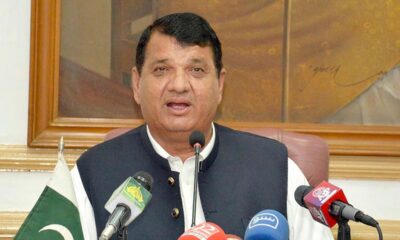Science & Technology
Smart charging may be key to saving power grid in world of EVs

As electric vehicle (EV) sales rise, the big question for power grid operators, charging companies and governments is how to run tens of millions of vehicles without crashing local networks or spending billions on grid upgrades.
The answer: smart charging.
Simply put, smart charging software allows EV owners to plug in during expensive peak hours, without the vehicle drawing power until cheap off-peak hours. This eases strain on the electric grid, makes better use of renewable energy and saves drivers money.
Without it, millions of EV owners plugging in after work – auditing firm EY estimates Europe will have 65 million EVs by 2030 and 130 million by 2035 – could overload local grids, causing blackouts.
“The shift to electric will be nigh on impossible without smart charging,” Chris Pateman-Jones, CEO of British EV charger company Connected Kerb, told Reuters while demonstrating a pilot project on public chargers in Hackney, a London borough.
Using Connected Kerb’s smartphone app you can set your charging speed, charge time and exact price down to a low, slow “Eco” rate of 19 pence (26 U.S. cents) per kilowatt.
“It’s so much cheaper and simpler,” said Ged O’Sullivan, a 65-year-old pub owner who cut his plug-in hybrid’s charging bill by 30% with Connected Kerb.
Smart charging for public chargers is a significant challenge because so few are available for people who cannot charge at home because they park on the street.
According to a report from EY and Eurelectric, Europe alone will need 9 million public chargers by 2035, up from 374,000 today.
The near future should also bring “bidirectional” or “vehicle-to-grid” charging, where millions of EV owners could sell their EV batteries’ juice back to grid operators during peak hours.
Even in Britain where smart charging at home is widely available, many EV owners are unaware it exists, according to Britain’s energy regulator, Ofgem. In the United States, only a tiny fraction of utilities offer it, according to utilities group the Smart Electric Power Alliance.
And few cars today beside Renault and Hyundai’s upcoming Ioniq model are capable of bidirectional charging – though more are coming.
“Most cars, at this point, do not support this bidirectional charging yet,” said Robin Berg, CEO of We Drive Solar, which has supplied hundreds of bidirectional chargers for a pilot project in the central Dutch city of Utrecht and worked with Renault SA (RENA.PA) and Hyundai Motor Co (005380.KS) on their vehicles. “Other carmakers will follow.”
Nearly 20% of new cars sold in the Netherlands and almost 12% in Britain in 2021 were fully electric.
State support has put Norway at the forefront of electrification, where EVs made up almost three-quarters of sales in the capital Oslo. Some local substations were built in the 1950s and without smart charging Oslo would need massive, costly grid upgrades.
“To handle this we need smart charging solutions because we don’t want to over-invest in the grid,” said Sture Portvik, who heads Oslo’s charging infrastructure efforts.
‘AWARENESS IS LOW’
Connected Kerb aims to have 190,000 UK on-street chargers by 2030, enabling it to predict consumer charging patterns for grid operators and offer lower rates when the available renewable energy is abundant, said Pateman-Jones.
“Today when there’s too much wind on the grid, wind farms are told to turn the wind turbines off,” he said. “With smart charging we can pull more of that power.”
Some UK energy providers already offer low off-peak rates for home smart charging, but few EV owners use them.
“The perception is smart charging at home is a done deal,” said Charlie Cook, CEO of Rightcharge, a UK firm that helps EV owners find low tariffs. “But the reality is awareness of these tariffs is surprisingly low.”
Rightcharge estimates smart charging could save UK drivers 10 billion pounds ($13.5 billion) by 2030.
British car dealer network Lookers (LOOK.L) guides EV buyers to Rightcharge’s website to check their options.
Lookers’ business development director, Andrew Hall, said “early adopter” EV buyers are “pretty savvy about smart charging.”
“But that is changing as EV sales rise,” he added.
Utilities group the Smart Electric Power Alliance estimates only 50 out of 3,000 U.S. utilities offer smart charging.
EV charging company ChargePoint’s (CHPT.N) U.S. chargers can all smart-charge, but it wants more utilities to offer it.
“We see a lot of positive response from customers when their utility is offering those rates,” said Anthony Harrison, ChargePoint’s North American head of utility partnerships.
Charging provider Blink Charging Co (BLNK.O) has one set rate until smart charging is widely available.
“We decided to keep it simple for our customers,” said Blink CEO Michael Farkas.
‘HORRENDOUSLY EXPENSIVE’
Bidirectional charging may be crucial.
“The whole idea behind bidirectional charging is to balance the grid,” said We Drive Solar’s Berg, who estimates a fully charged EV can power the average home in the Netherlands for a week.
Serge Colle, EY’s global energy resources leader, said smart and bidirectional charging are better than “horrendously expensive” power grid upgrades.
“We can’t possibly open up streets quickly enough to add more copper and do the necessary reinforcement,” Colle said.
Regulator Ofgem estimates that peak power reductions from smart and bidirectional charging by 2050 could match “10 Hinkley Point C Nuclear Plants” – a two-reactor plant under construction in England.
The U.S. market has more than 10 vehicle-to-grid pilot projects using school buses under way.
California-based vehicle-to-grid company Nuvve Holding Corp (NVVE.O) has formed Levo, a joint venture with private equity firm Stonepeak – which chipped in $750 million – to enable EV fleet owners to sell power to utilities.
“Because our customers are able to generate revenue we’re able to reduce the total cost of ownership for those vehicles, at times completely cost-neutral,” said Nuvve CEO Gregory Poilasne.
Charger makers like Brisbane, Australia-based Tritium Dcfc Ltd (DCFC.O) are also developing bidirectional chargers.
CEO Jane Hunter said Tritium will launch a bidirectional, fast-charging wall unit in 2023 for fleets and homeowners.
More automakers are embracing bidirectional charging. Ford Motor Co (F.N) has partnered with solar power company Sunrun Inc (RUN.O) to use its F-150 Lightning pickup truck to power homes.
But Oslo has invested extra money in pilot projects for bidirectional chargers because it believes in the concept. So far, however, it has been disappointed that more carmakers have not yet introduced vehicles that can feed power back into the grid.
“The limitations for bidirectional charging has been the car producers,” infrastructure chief Portvik said. “The big carmakers have to step up.”
Science & Technology
Apple loses top phonemaker spot to Samsung as iPhone shipments drop, IDC says

Apple’s (AAPL.O), opens new tab smartphone shipments dropped about 10% in the first quarter of 2024, hurt by intensifying competition by Android smartphone makers aiming for the top spot, data from research firm IDC showed on Sunday.
Global smartphone shipments increased 7.8% to 289.4 million units during January-March, with Samsung (005930.KS), opens new tab, at 20.8% market share, clinching the top phonemaker spot from Apple, Reuters reported.
The iPhone-maker’s steep sales decline comes after its strong performance in the December quarter when it overtook Samsung as the world’s No.1 phone maker. It’s back to the second spot, with 17.3% market share, as Chinese brands such as Huawei gain market share.
Xiaomi, one of China’s top smartphone makers, occupied the third position with a market share of 14.1% during the first quarter, read the report.
South Korea’s Samsung, which launched its latest flagship smartphone lineup – Galaxy S24 series – in the beginning of the year, shipped more than 60 million phones during the period.
Global sales of Galaxy S24 smartphones jumped 8%, compared to last year’s Galaxy S23 series during their first three weeks of availability, data provider Counterpoint previously said.
In the first quarter, Apple shipped 50.1 million iPhones, down from 55.4 million units it shipped same period last year, according to IDC.
Apple’s smartphone shipments in China shrank 2.1% in the final quarter of 2023 from a year earlier.
The drop underscores the challenges facing the U.S. firm in its third biggest market, as some Chinese companies and government agencies limit employees’ use of Apple devices, a measure that mirrors U.S. government restrictions on Chinese apps on security grounds.
The Cupertino, California-based company in June will hold its Worldwide Developers Conference (WWDC), where it will highlight updates to the software powering iPhones, iPads, and other Apple devices.
Investors are closely watching for updates on artificial intelligence development at Apple, which has so far spoken little about incorporating the AI technology into its devices. The company earlier this year lost the crown as the world’s most valuable company to Microsoft (MSFT.O), opens new tab, Reuters reported.
Science & Technology
China launch of relay satellite Queqiao-2 for lunar probe mission successful

China National Space Administration (CNSA) said on Friday its launch of a key signal relay satellite was a “complete success” and it would serve as the communication bridge for its future lunar probe missions for years to come, state media reported.
China launched the satellite Queqiao-2, which was named after a mythological bridge made of magpies, and two miniature satellites, Tiandu-1 and Tiandu-2, on March 20.
Queqiao-2 will be used as a communications bridge between the ground operations on earth and upcoming lunar probe missions on the far side of the moon until at least 2030.
The moon’s near side always faces earth. That means data transfers from the far side are impossible because there is no direct line of sight.
Queqiao-2 researcher and developer Xiong Liang described the satellite as “the main switch” of the whole fourth phase of lunar missions, according to state television CCTV.
“Only when the main switch is flipped on, all the communications can kick off,” Xiong said.
Queqiao-2 will orbit the moon and relay signals to and from the Chang’e-6 mission, which expected to be launched in May. The robotic Chang’e-6 probe will seek to retrieve samples from an ancient basin, acquiring lunar material from the moon’s hidden side for the first time.
Queqiao-2 will also be used as a relay platform for the Chang’e-7 lunar mission in 2026 and the Chang’e-8 mission in 2028.
The functions and performance of Queqiao-2 met mission requirements and it will be able to provide relay communication services for China’s lunar exploration projects and future lunar missions for China and other countries, said the CNSA, according to CCTV.
Queqiao-2 entered its targeted elliptical orbit on April 2 after a correction midway, near-moon braking and orbital manoeuvre around the moon, CNSA said.
The satellite has successfully communicated with Chang’e 4, which was the first spacecraft to perform a soft landing on the far side of the moon and is still carrying out its exploration mission. It also communicated with the Chang’e-6 probe while it is still on the ground earlier this month.
The successful launch of Queqiao-2 comes after the failed launch of another lunar spacecraft DRO-A/B satellites, which was intended to enter the moon’s distant retrograde orbit (DRO).
China has not released any information on whether or not the satellites can be retrieved.
(Reuters)
Science & Technology
Russia aborts planned test launch of new heavy-lift space rocket

Russian space officials on Tuesday aborted the test launch of a new heavy-lift rocket from its far-eastern launch pad.
The Angara-A5 rocket was scheduled to lift off from the Vostochny space launch facility at 0900 GMT Tuesday, but the launch was aborted two minutes before, AP reported.
Yuri Borisov, head of Roscosmos state space corporation, said the automatic safety system canceled the launch after registering a flaw in the oxidizer tank pressurization system.
He said the next launch attempt was set for Wednesday.
Tuesday’s launch was to be the fourth for the Angara-A5, a heavy-lift version of the new Angara family of rockets that has been developed to replace the Soviet-designed Proton rockets.
-

 Latest News5 days ago
Latest News5 days agoPakistan’s frontiers minister stresses ‘dignified’ return of Afghan refugees
-

 Latest News3 days ago
Latest News3 days agoRashid Khan named AWCC’s brand ambassador
-

 Regional4 days ago
Regional4 days agoIranian president lands in Pakistan for three-day visit to mend ties
-

 Climate Change5 days ago
Climate Change5 days agoMassive river flooding expected in China, threatening millions
-

 Latest News5 days ago
Latest News5 days agoChinese keen to invest in Panjshir-Kabul water conduit project
-

 World5 days ago
World5 days agoTwo Japan navy helicopters crash, one body found, 7 missing
-

 Sport4 days ago
Sport4 days agoKolkata beat Bengaluru by one run in IPL as Kohli fumes at dismissal
-

 Sport4 days ago
Sport4 days agoACL: Aino Mina 3-0 Istiqlal Kabul; Attack Energy 3-0 Khadim
























